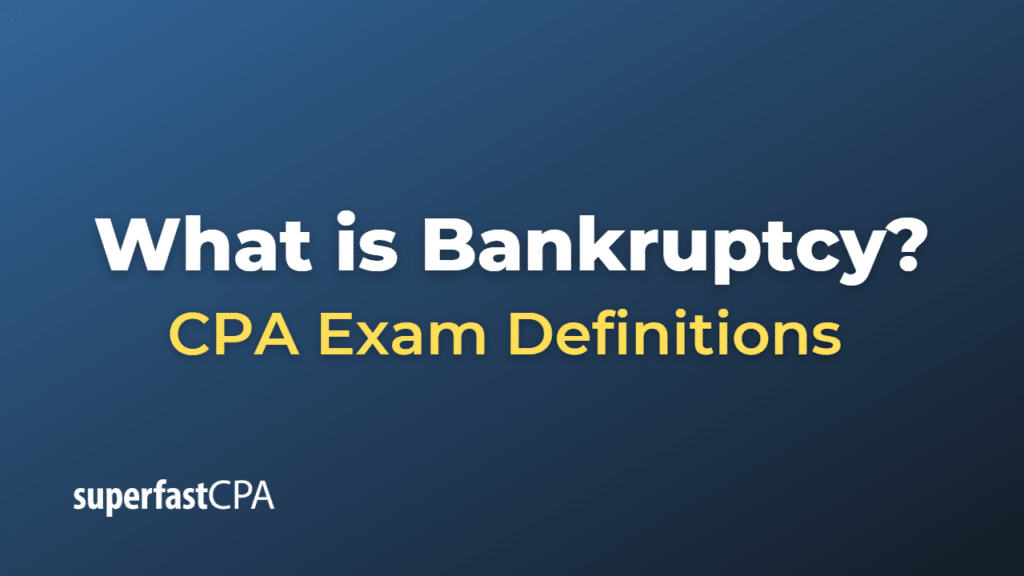Bankruptcy
Bankruptcy is a legal process that individuals or businesses go through when they are unable to repay their outstanding debts. The primary purpose of bankruptcy is to provide financial relief to the debtor and to fairly distribute their assets among creditors. Bankruptcy laws vary by country, and different types of bankruptcy exist to address various financial situations.
In the United States, bankruptcy is governed by federal law, specifically the U.S. Bankruptcy Code, and is conducted through the bankruptcy courts. The most common types of bankruptcy in the United States are:
- Chapter 7 bankruptcy: Also known as “liquidation bankruptcy,” this type is generally filed by individuals who have little or no disposable income and are unable to repay their debts. Under Chapter 7, a court-appointed trustee sells the debtor’s non-exempt assets and distributes the proceeds among the creditors. At the end of the process, most of the debtor’s unsecured debts are discharged, providing them with a fresh financial start.
- Chapter 11 bankruptcy: This form of bankruptcy is primarily used by businesses seeking to reorganize their debts and continue operations. Under Chapter 11, the debtor proposes a reorganization plan to the court and creditors, which may include renegotiating contracts, reducing expenses, or selling assets. If the plan is approved, the debtor must follow the plan and repay its debts over a specified period.
- Chapter 13 bankruptcy: Also known as “wage earner’s bankruptcy,” Chapter 13 is designed for individuals with a regular income who want to repay their debts but need a structured repayment plan. Under Chapter 13, the debtor proposes a repayment plan to the court, which usually lasts three to five years. During this time, the debtor makes payments to a court-appointed trustee, who distributes the funds to the creditors. Upon successful completion of the repayment plan, the remaining unsecured debts are discharged.
Bankruptcy can have significant consequences for both debtors and creditors. For debtors, filing for bankruptcy can provide relief from overwhelming debts, but it can also negatively impact their credit score and make it challenging to obtain credit in the future. For creditors, bankruptcy may result in receiving only a portion of the amount owed, or in some cases, nothing at all. However, bankruptcy laws aim to strike a balance between providing relief to the debtor and ensuring fair treatment for the creditors.
Example of Bankruptcy
Let’s consider a fictional example of an individual named Mark who is facing financial difficulties and decides to file for bankruptcy.
Mark, a 40-year-old single father of two, has been struggling to manage his finances after losing his job. Despite his efforts to find a new job and cut back on expenses, he has accumulated $70,000 in credit card debt, $30,000 in medical bills, and has fallen behind on his mortgage payments, putting him at risk of foreclosure.
After consulting with a bankruptcy attorney, Mark decides to file for Chapter 7 bankruptcy, as his current income is not sufficient to repay his debts.
- Mark files a bankruptcy petition with the local bankruptcy court, providing information about his assets, liabilities, income, and expenses.
- The court appoints a trustee to oversee Mark’s case and assess his financial situation.
- The trustee reviews Mark’s assets to determine which ones are exempt (such as clothing, household goods, and a portion of the equity in his home) and which ones are non-exempt and can be sold to repay his creditors.
- The trustee sells Mark’s non-exempt assets, such as his second car and valuable collectibles, and distributes the proceeds among his creditors.
- Mark’s unsecured debts, such as his credit card debt and medical bills, are discharged at the end of the bankruptcy process, providing him with a fresh financial start. However, certain debts, like student loans and child support, are generally not dischargeable in bankruptcy.
- Mark is able to keep his home, as he works out a loan modification plan with his mortgage lender to catch up on missed payments and avoid foreclosure.
In this example, filing for Chapter 7 bankruptcy allowed Mark to eliminate his unsecured debts and keep his home, giving him the opportunity to rebuild his financial life. However, it’s essential to note that bankruptcy will remain on Mark’s credit report for up to 10 years, making it more challenging for him to obtain credit during that time.













